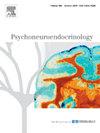Emotion dysregulation modulates the relation between emotional intensity and biological stress dysregulation among community women experiencing intimate partner violence
IF 3.6
2区 医学
Q2 ENDOCRINOLOGY & METABOLISM
引用次数: 0
Abstract
Women experiencing intimate partner violence (IPV) are exposed to chronic stress. Stress has well-documented adverse effects on a range of health outcomes, particularly among women. The current study utilized rigorous methodology to advance understanding of stress dysregulation in women experiencing IPV. Specifically, we examined whether emotion dysregulation moderated the association between negative emotional intensity and HPA-axis dysfunction derived from hair cortisol (i.e., hyperactivity or excess cortisol production). The final sample included 95 women who were recruited from the community (Mage = 41.01; 44.6 % Black, Indigenous, or other Person of Color). Women reported on negative emotional intensity and emotion dysregulation three times a day for 30 days, and average (i.e., within-person mean) negative emotional intensity and emotion dysregulation scores were calculated. A hair sample was provided immediately following this 30-day period during a follow-up interview. We found that the relation between negative emotional intensity and hair cortisol levels was significant among women who reported high (but not low) emotion dysregulation. These findings advance research on the sustained (chronic) relations among negative emotional intensity, emotion dysregulation, and HPA-axis dysfunction, and underscore the need for additional research in this area.
社区妇女遭受亲密伴侣暴力时,情绪失调调节情绪强度与生物应激失调的关系。
遭受亲密伴侣暴力的妇女面临慢性压力。有充分证据表明,压力对一系列健康结果产生不利影响,特别是对妇女而言。目前的研究采用了严格的方法来推进对IPV女性压力失调的理解。具体而言,我们研究了情绪失调是否会减缓负面情绪强度与毛发皮质醇(即多动或过量皮质醇产生)引起的hpa轴功能障碍之间的关联。最终样本包括从社区招募的95名女性(法师= 41.01;44.6% %黑人、原住民或其他有色人种)。女性每天三次报告负面情绪强度和情绪失调,持续30天,并计算平均(即个人平均)负面情绪强度和情绪失调得分。在这30天的随访期间,立即提供头发样本。我们发现,负面情绪强度和头发皮质醇水平之间的关系在那些情绪失调程度高(但不是低)的女性中是显著的。这些发现推动了对负性情绪强度、情绪失调和hpa轴功能障碍之间持续(慢性)关系的研究,并强调了该领域进一步研究的必要性。
本文章由计算机程序翻译,如有差异,请以英文原文为准。
求助全文
约1分钟内获得全文
求助全文
来源期刊

Psychoneuroendocrinology
医学-精神病学
CiteScore
7.40
自引率
8.10%
发文量
268
审稿时长
66 days
期刊介绍:
Psychoneuroendocrinology publishes papers dealing with the interrelated disciplines of psychology, neurobiology, endocrinology, immunology, neurology, and psychiatry, with an emphasis on multidisciplinary studies aiming at integrating these disciplines in terms of either basic research or clinical implications. One of the main goals is to understand how a variety of psychobiological factors interact in the expression of the stress response as it relates to the development and/or maintenance of neuropsychiatric illnesses.
 求助内容:
求助内容: 应助结果提醒方式:
应助结果提醒方式:


